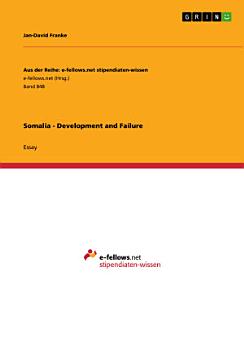Somalia - Development and Failure
nov. de 2013 · Aus der Reihe: e-fellows.net stipendiaten-wissen Libro 848 · GRIN Verlag
3,0star
1 recensiónreport
Libro electrónico
15
Páxinas
family_home
Apto
info
reportAs valoracións e as recensións non están verificadas Máis información
Acerca deste libro electrónico
Essay from the year 2012 in the subject Politics - Topic: Development Politics, grade: 1.3, Jacobs University Bremen gGmbH, course: USC - Theories of Development, language: English, abstract: Somalia is a country in the East of Africa, situated at the horn of Africa with a population of ca. 9.3 million (BTI 2012). In this part of the world, life is hard (e.g. infant mortality rate: 10%) and short (life expectancy at birth: 51 years). “Freedom in the World 2012” by Freedom House gives Somalia the worst possible rating both for political rights and civil liberties. It ranks at place 223 of 227 in terms of GDP per capita (CIA Factbook, 2012). The Global Peace Index lists Somalia as the most dangerous country in the world while the Transitional Federal Government of Somalia (TFG), which is supported by the United Nations, the African Union and the United States, merely controls parts of the capital Mogadishu (Bruton, 2009). Around 40% of Somali territory is occupied by a radical muslim militia called Al-Shabab. The famine that befell the horn of Africa in 2011 struck Somalia worst, a country, which is mostly referred to as a ‘failed state’ for 20 years now. The situation in Somalia, so much is clear, is very serious and appalling in a variety of fields. But why is that? In this paper I will describe Somalia’s recent development in the framework introduced by Szirmai (2005: pp. 29-33), using his 9 characteristics of developing countries for classification, and - building up on that - inquire into possible explanations for its deficiencies and its failure as a state.
Valoracións e recensións
3,0
1 recensión
Valora este libro electrónico
Dános a túa opinión.
Información de lectura
Smartphones e tabletas
Instala a aplicación Google Play Libros para Android e iPad/iPhone. Sincronízase automaticamente coa túa conta e permíteche ler contido en liña ou sen conexión desde calquera lugar.
Portátiles e ordenadores de escritorio
Podes escoitar os audiolibros comprados en Google Play a través do navegador web do ordenador.
Lectores de libros electrónicos e outros dispositivos
Para ler contido en dispositivos de tinta electrónica, como os lectores de libros electrónicos Kobo, é necesario descargar un ficheiro e transferilo ao dispositivo. Sigue as instrucións detalladas do Centro de axuda para transferir ficheiros a lectores electrónicos admitidos.












